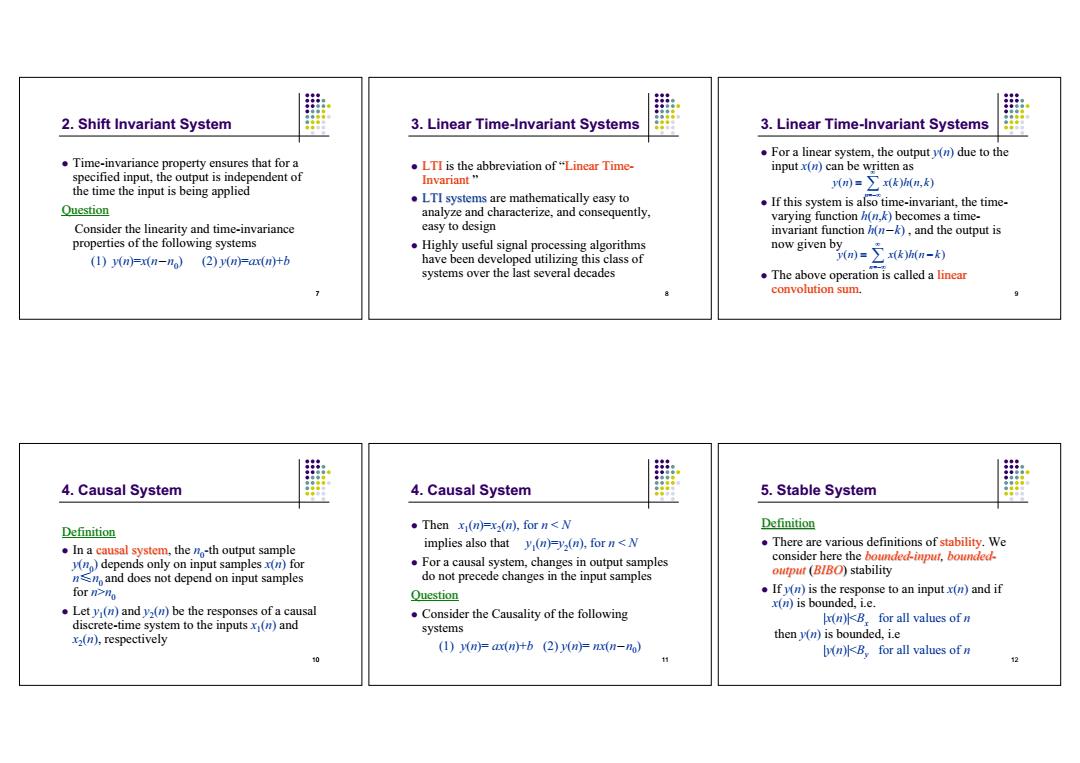正在加载图片...

2.Shift Invariant System 3.Linear Time-Invariant Systems 3.Linear Time-Invariant Systems For a linear system,the output y(n)due to the Time-invariance property ensures that for a .LTI is the abbreviation of"Linear Time- inputx(n)can be written as specified input,the output is independent of Invariant" (m)=∑x(k)h(n,k) the time the input is being applied .LTI systems are mathematically easy to Question .If this system is also time-invariant,the time- analyze and characterize,and consequently, varying function h(n,k)becomes a time- Consider the linearity and time-invariance easy to design invariant function /(n-k),and the output is properties of the following systems Highly useful signal processing algorithms now given by (1)y(n)=x(n-n)(2)y(n)=ax(n)+b have been developed utilizing this class of m=Σ- systems over the last several decades The above operation is called a linear convolution sum. 4.Causal System 4.Causal System 5.Stable System Definition ●Then x(n=x(,forn<N Definition 。In a causal system,then。-th output sample implies also that y (n)=v (n),for n<N There are various definitions of stability.We wn)depends only on input samples xn)for For a causal system,changes in output samples consider here the bounded-input,bounded. n≤,and does not depend on input samples do not precede changes in the input samples output (BIBO)stability for n>no Question If wn)is the response to an input x(n)and if x()is bounded.i.e. Let y (n)and y,(n)be the responses of a causal .Consider the Causality of the following discrete-time system to the inputs x(n)and (n)B,for all values of n systems x2(n),respectively then yn)is bounded.i.e (1)y(n)=ax(n)+b (2)y(n=nx(n-no) l(n)B,for all values of n 117 2. Shift Invariant System Time-invariance property ensures that for a specified input, the output is independent of the time the input is being applied Question Consider the linearity and time-invariance properties of the following systems (1) y(n)=x(nˉn0) (2) y(n)=ax(n)+b 8 3. Linear Time-Invariant Systems LTI is the abbreviation of “Linear Time Linear TimeInvariant Invariant ” LTI systems LTI systems are mathematically easy to analyze and characterize, and consequently, easy to design Highly useful signal processing algorithms have been developed utilizing this class of systems over the last several decades 9 3. Linear Time-Invariant Systems For a linear system, the output y(n) due to the input x(n) can be written as If this system is also time-invariant, the timevarying function h(n,k) becomes a timeinvariant function h(nˉk) , and the output is now given by The above operation is called a linear convolution sum. () ()(, ) n yn xkhnk () ()( ) n yn xkhn k 10 4. Causal System Definition In a causal system, the n0-th output sample y(n0) depends only on input samples x(n) for nİn0 and does not depend on input samples for n>n0 Let y1(n) and y2(n) be the responses of a causal discrete-time system to the inputs x1(n) and x2(n), respectively 11 4. Causal System Then x1(n)=x2(n), for n < N implies also that y1(n)=y2(n), for n < N For a causal system, changes in output samples do not precede changes in the input samples Question Consider the Causality of the following systems (1) y(n)= ax(n)+b (2) y(n)= nx(nˉn0) 12 5. Stable System Definition There are various definitions of stability. We consider here the bounded-input, boundedoutput (BIBO) stability ) If y(n) is the response to an input x(n) and if x(n) is bounded, i.e. |x(n)|<Bx for all values of n then y(n) is bounded, i.e |y(n)|<By for all values of n������������������